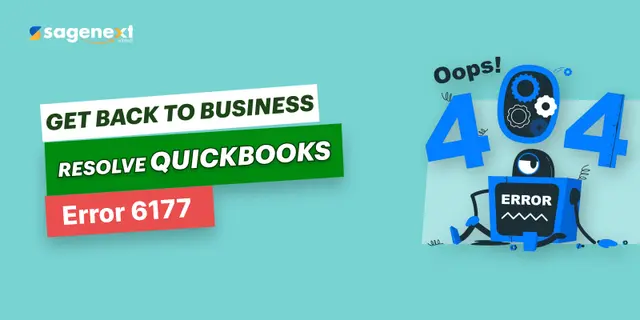 QuickBooks · May 6th 2025 · 7 Min read
QuickBooks · May 6th 2025 · 7 Min readHow to Fix QuickBooks Error 6177, 0?
Table of Contents:
- Introduction
- Step 1: Update your QuickBooks Desktop
- Step 2: Update the file location
- Step 3: Download & run File Doctor on the server
- Step 4: Manually fix your file path
- Full version of QuickBooks on your server
Introduction
If you’re seeing error -6177,0, you are required to fix it immediately. For this, you need to move the company file.
If someone is having a full version of QuickBooks Desktop on their server PC, they need to follow the below-listed steps:
Step 1: Update your QuickBooks Desktop
Make sure your QuickBooks application is up to date, if not you need to make certain that the current version is installed.
Step 2: Update the file location
A user who maintains their company file on a server, or external hard drive, or in the cloud can easily alter the location. You need to do the below-listed steps to move the file to your local drive:
Move your company file
Note: You’re required to execute these steps on the server PC (the system that hosts your company files). If users don’t have access to it, then you need to follow these steps on one of your systems. (The system connected to your server doesn’t host the company files).
- Within the start menu, find the “File Explorer” and open it.
- Start QuickBooks and find the company file with QBW extension. The file will look like: [company name].qbw.
- Type your drive name & location. Here’s an example:
- Transfer your company file to C: drive from this folder.
Generate a portable company file & restore it to your server
The company file is on a local drive and you can make a portable file. It will be a compact version of your financial data.
- Run QuickBooks Desktop on the PC you’ve moved the company file to.
- Tap on the Open/restore an existing company.
- Search for and run the company file which has moved to C: drive.
- Make a portable company file. It creates a company files portable version that also sets your file location data.
- Navigate to the File menu and choose Quit QuickBooks.
- Tap on Open or Restore Company and select Restore a portable file.
- Search and click on the portable company file (QBM) you created. Next, select Open and Next.
- To make the restore of location, click on the drive you originally transferred your company file from.
- Choose Save. It will put the company file again on the network.
- Click on the File menu and tap on Quit QuickBooks.
Step 3: Download & run File Doctor on the server
Download and run File Doctor. It helps in cleaning the company file by detecting and diagnosing problems. If in case it resolves your issue, ascertain to create a backup of your company file.
Step 4: Manually fix your file path
Find the ND file
- Go to the QuickBooks folder from file explorer.
- Locate the file having the company name and ND at the end. For example: [MyCompanyFileName].qbw.nd.
- Double-click the ND file and click on Delete.
Configure your QuickBooks Database Server Manager.
- Install QB Database Server Manager from the official website.
- Go to the Windows Start menu on the server computer and enter “Database”.
- Run the QuickBooks Database Server Manager.
- Click on the QuickBooks folder with company files.
- Tap on Start Scan and close.
- Set the folder permissions to share the company files.
- Run the application and your problem will get resolved.
Steps to follow if you have the full version of QuickBooks on your server:
Users having the full version of QuickBooks Desktop installed on the main system need to follow the below-listed steps:
Step 1: Reset multi-user hosting
- Start QuickBooks on your main system and go to the utility tab.
- Click on the Stop Hosting Multi-User Access.
- Go to the File menu and choose Quit QuickBooks.It will reset your hosting settings
- Start again QuickBooks, but don’t access your company file.
- Click on the File menu and select Host Multi-User Access on utilities.
Step 2: Move the company file to the server’s local hard drive
Same as the above.
Step 3: Create a portable company file
Browse and open company file you’ve just moved to your C: drive.
Step 4: Generate a new folder for QuickBooks
- On the QuickBooks folder, make a new folder on the server’s local C: drive.
- Next, copy all folders including the portable company file on this folder.
Step 5: Start QuickBooks
- Run the QuickBooks.
- Click on the Open or restore an existing company rather than choosing a company from the list.
- Tap on the Open a company file and then Next.
- Open the portable company file (QBM) you moved to the new folder.
Open QuickBooks on all of your computers. Everything should be fixed

